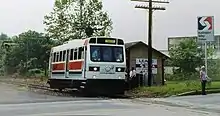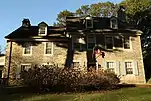Fox Chase Line
The Fox Chase Line is a route of the SEPTA Regional Rail (commuter rail) system. The Fox Chase Line branches from the SEPTA Main Line at Newtown Junction, north of the Wayne Junction station. It runs entirely within the city of Philadelphia. The line is fully grade-separated, except for one grade crossing on Oxford Avenue. Under the Reading Company service continued north to Newtown, but this ended in January 1983. Various proposals to resume this service have failed, and the line within Montgomery County has been gradually converting into a rail trail from 2008 onward, ending any chance of resumed passenger service on the abandoned section of line for the foreseeable future.
| Fox Chase Line | ||||||||||||||||||||||||||||||||||||||||||||||||||||||||||||||||||||||||||||||||||||||||||||||||||||||||||||||||||||||||||||||||||||||||||||||||||||||||||||||||||||||||||||||||||||||||||||||||||||||||||||||||||||||||||||||||||||||||||||||||||||||||||||||||||||||||||||||||||||||||||||||||||
|---|---|---|---|---|---|---|---|---|---|---|---|---|---|---|---|---|---|---|---|---|---|---|---|---|---|---|---|---|---|---|---|---|---|---|---|---|---|---|---|---|---|---|---|---|---|---|---|---|---|---|---|---|---|---|---|---|---|---|---|---|---|---|---|---|---|---|---|---|---|---|---|---|---|---|---|---|---|---|---|---|---|---|---|---|---|---|---|---|---|---|---|---|---|---|---|---|---|---|---|---|---|---|---|---|---|---|---|---|---|---|---|---|---|---|---|---|---|---|---|---|---|---|---|---|---|---|---|---|---|---|---|---|---|---|---|---|---|---|---|---|---|---|---|---|---|---|---|---|---|---|---|---|---|---|---|---|---|---|---|---|---|---|---|---|---|---|---|---|---|---|---|---|---|---|---|---|---|---|---|---|---|---|---|---|---|---|---|---|---|---|---|---|---|---|---|---|---|---|---|---|---|---|---|---|---|---|---|---|---|---|---|---|---|---|---|---|---|---|---|---|---|---|---|---|---|---|---|---|---|---|---|---|---|---|---|---|---|---|---|---|---|---|---|---|---|---|---|---|---|---|---|---|---|---|---|---|---|---|---|---|---|---|---|---|---|---|---|---|---|---|---|---|---|---|---|---|---|---|---|---|---|---|---|---|---|---|---|---|---|---|
 Fox Chase station in December 2012 | ||||||||||||||||||||||||||||||||||||||||||||||||||||||||||||||||||||||||||||||||||||||||||||||||||||||||||||||||||||||||||||||||||||||||||||||||||||||||||||||||||||||||||||||||||||||||||||||||||||||||||||||||||||||||||||||||||||||||||||||||||||||||||||||||||||||||||||||||||||||||||||||||||
| Overview | ||||||||||||||||||||||||||||||||||||||||||||||||||||||||||||||||||||||||||||||||||||||||||||||||||||||||||||||||||||||||||||||||||||||||||||||||||||||||||||||||||||||||||||||||||||||||||||||||||||||||||||||||||||||||||||||||||||||||||||||||||||||||||||||||||||||||||||||||||||||||||||||||||
| Status | Operating | |||||||||||||||||||||||||||||||||||||||||||||||||||||||||||||||||||||||||||||||||||||||||||||||||||||||||||||||||||||||||||||||||||||||||||||||||||||||||||||||||||||||||||||||||||||||||||||||||||||||||||||||||||||||||||||||||||||||||||||||||||||||||||||||||||||||||||||||||||||||||||||||||
| Termini | Fox Chase 30th Street Station | |||||||||||||||||||||||||||||||||||||||||||||||||||||||||||||||||||||||||||||||||||||||||||||||||||||||||||||||||||||||||||||||||||||||||||||||||||||||||||||||||||||||||||||||||||||||||||||||||||||||||||||||||||||||||||||||||||||||||||||||||||||||||||||||||||||||||||||||||||||||||||||||||
| Stations | 10 | |||||||||||||||||||||||||||||||||||||||||||||||||||||||||||||||||||||||||||||||||||||||||||||||||||||||||||||||||||||||||||||||||||||||||||||||||||||||||||||||||||||||||||||||||||||||||||||||||||||||||||||||||||||||||||||||||||||||||||||||||||||||||||||||||||||||||||||||||||||||||||||||||
| Website | septa.org | |||||||||||||||||||||||||||||||||||||||||||||||||||||||||||||||||||||||||||||||||||||||||||||||||||||||||||||||||||||||||||||||||||||||||||||||||||||||||||||||||||||||||||||||||||||||||||||||||||||||||||||||||||||||||||||||||||||||||||||||||||||||||||||||||||||||||||||||||||||||||||||||||
| Service | ||||||||||||||||||||||||||||||||||||||||||||||||||||||||||||||||||||||||||||||||||||||||||||||||||||||||||||||||||||||||||||||||||||||||||||||||||||||||||||||||||||||||||||||||||||||||||||||||||||||||||||||||||||||||||||||||||||||||||||||||||||||||||||||||||||||||||||||||||||||||||||||||||
| Type | Commuter rail | |||||||||||||||||||||||||||||||||||||||||||||||||||||||||||||||||||||||||||||||||||||||||||||||||||||||||||||||||||||||||||||||||||||||||||||||||||||||||||||||||||||||||||||||||||||||||||||||||||||||||||||||||||||||||||||||||||||||||||||||||||||||||||||||||||||||||||||||||||||||||||||||||
| System | SEPTA Regional Rail | |||||||||||||||||||||||||||||||||||||||||||||||||||||||||||||||||||||||||||||||||||||||||||||||||||||||||||||||||||||||||||||||||||||||||||||||||||||||||||||||||||||||||||||||||||||||||||||||||||||||||||||||||||||||||||||||||||||||||||||||||||||||||||||||||||||||||||||||||||||||||||||||||
| Operator(s) | SEPTA | |||||||||||||||||||||||||||||||||||||||||||||||||||||||||||||||||||||||||||||||||||||||||||||||||||||||||||||||||||||||||||||||||||||||||||||||||||||||||||||||||||||||||||||||||||||||||||||||||||||||||||||||||||||||||||||||||||||||||||||||||||||||||||||||||||||||||||||||||||||||||||||||||
| Rolling stock | Electric Multiple Units | |||||||||||||||||||||||||||||||||||||||||||||||||||||||||||||||||||||||||||||||||||||||||||||||||||||||||||||||||||||||||||||||||||||||||||||||||||||||||||||||||||||||||||||||||||||||||||||||||||||||||||||||||||||||||||||||||||||||||||||||||||||||||||||||||||||||||||||||||||||||||||||||||
| Daily ridership | 4,955 (FY 2018)[1] | |||||||||||||||||||||||||||||||||||||||||||||||||||||||||||||||||||||||||||||||||||||||||||||||||||||||||||||||||||||||||||||||||||||||||||||||||||||||||||||||||||||||||||||||||||||||||||||||||||||||||||||||||||||||||||||||||||||||||||||||||||||||||||||||||||||||||||||||||||||||||||||||||
| History | ||||||||||||||||||||||||||||||||||||||||||||||||||||||||||||||||||||||||||||||||||||||||||||||||||||||||||||||||||||||||||||||||||||||||||||||||||||||||||||||||||||||||||||||||||||||||||||||||||||||||||||||||||||||||||||||||||||||||||||||||||||||||||||||||||||||||||||||||||||||||||||||||||
| Opened | 1878 | |||||||||||||||||||||||||||||||||||||||||||||||||||||||||||||||||||||||||||||||||||||||||||||||||||||||||||||||||||||||||||||||||||||||||||||||||||||||||||||||||||||||||||||||||||||||||||||||||||||||||||||||||||||||||||||||||||||||||||||||||||||||||||||||||||||||||||||||||||||||||||||||||
| Closed | 1983 (north of Fox Chase) | |||||||||||||||||||||||||||||||||||||||||||||||||||||||||||||||||||||||||||||||||||||||||||||||||||||||||||||||||||||||||||||||||||||||||||||||||||||||||||||||||||||||||||||||||||||||||||||||||||||||||||||||||||||||||||||||||||||||||||||||||||||||||||||||||||||||||||||||||||||||||||||||||
| Technical | ||||||||||||||||||||||||||||||||||||||||||||||||||||||||||||||||||||||||||||||||||||||||||||||||||||||||||||||||||||||||||||||||||||||||||||||||||||||||||||||||||||||||||||||||||||||||||||||||||||||||||||||||||||||||||||||||||||||||||||||||||||||||||||||||||||||||||||||||||||||||||||||||||
| Track gauge | 4 ft 8 1⁄2 in (1,435 mm) standard gauge | |||||||||||||||||||||||||||||||||||||||||||||||||||||||||||||||||||||||||||||||||||||||||||||||||||||||||||||||||||||||||||||||||||||||||||||||||||||||||||||||||||||||||||||||||||||||||||||||||||||||||||||||||||||||||||||||||||||||||||||||||||||||||||||||||||||||||||||||||||||||||||||||||
| Electrification | 12 kV / 25 Hz Catenary | |||||||||||||||||||||||||||||||||||||||||||||||||||||||||||||||||||||||||||||||||||||||||||||||||||||||||||||||||||||||||||||||||||||||||||||||||||||||||||||||||||||||||||||||||||||||||||||||||||||||||||||||||||||||||||||||||||||||||||||||||||||||||||||||||||||||||||||||||||||||||||||||||
| ||||||||||||||||||||||||||||||||||||||||||||||||||||||||||||||||||||||||||||||||||||||||||||||||||||||||||||||||||||||||||||||||||||||||||||||||||||||||||||||||||||||||||||||||||||||||||||||||||||||||||||||||||||||||||||||||||||||||||||||||||||||||||||||||||||||||||||||||||||||||||||||||||
History
The Fox Chase Line branches from the SEPTA Main Line at Newtown Junction, north of the Wayne Junction station. It runs entirely within the city of Philadelphia.
The line beyond Newtown Junction was originally opened February 2, 1878, to Newtown as the Philadelphia, Newtown and New York Railroad. The line was built by the Pennsylvania Railroad to block the building of the parallel National Railway (later the Reading Company's main line to New York City). After that failed, it was taken over by the North Pennsylvania Railroad (which had built the National Railway) on November 22, 1879. By then the Philadelphia and Reading Railway, later the Reading Company, had leased the North Pennsylvania Railroad. In 1976 the Reading was merged into Conrail, and in 1983 SEPTA took over commuter rail operations.
Between 1984 and 2010 the route was designated R8 Fox Chase as part of SEPTA's diametrical reorganization of its lines. Fox Chase trains operated through the city center to the Chestnut Hill West Line.[2] Plans had called for the Fox Chase Line to be paired with a Bryn Mawr local and designated R4, but this depended on a never-built connection from the Chestnut Hill West Line to the ex-Reading near Wayne Junction.[3] As of 2018, most Fox Chase Line trains continue through Center City to the Chestnut Hill West Line.[4]
SEPTA activated positive train control on the Fox Chase Line on May 23, 2016.[5]
Beyond Fox Chase


Under the Reading Company Budd Rail Diesel Cars (RDCs) operated through from the Reading Terminal in downtown Philadelphia to Newtown.[6] The Reading extended electrification to Fox Chase in 1966; limited diesel shuttles from Fox Chase to Newtown continued.[7] SEPTA suspended these shuttles on July 1, 1981, as part of a systemwide discontinuation of non-electrified service. The shuttles returned on October 5 as the Fox Chase Rapid Transit Line.[8] The operation of the line was troubled: the RDCs were in poor mechanical condition, SEPTA's decision to use transit division employees from the Broad Street Subway caused labor issues, and ridership was low.[9] SEPTA suspended service again on January 18, 1983.[10]
Since 1983, there has been interest from Bucks County passengers in resuming service to Newtown. In anticipation of a possible resumption, SEPTA performed extensive track upgrades in 1984. Street crossings in Newtown and Southampton received brand new welded rail, which were secured using sturdy Pandrol clips vs. traditional rail spikes. Though not promoted, this work was done in order to comply with a federal grant.[11]
By March 1985, SEPTA gave into political pressure and made a concerted effort to integrate the non-electrified Fox Chase-Newtown line into the rest of its all-electrified commuter system. A $10 million plan to restore service to Newtown and Pottstown using British Rail-Leyland diesel railbuses was considered, with a test run reaching Newtown on September 3. Though the trial runs were relatively successful, ride quality was lackluster. Burdened with ongoing budgetary problems, SEPTA decided against the purchase of the railbuses.[12]
In March 1987, SEPTA received several bids from private operators interested in running diesel-hauled trains to Newtown (as well as between Norristown and Pottstown). The operators suggested using non-union workers, which SEPTA was against. In addition, funding for these operations was allegedly questionable, and the SEPTA board rejected all offers.[13]
Beginning in 2009, portions on the line within Montgomery County have been converted into a rail trail.[9][14] By 2015, the Pennypack Trail extended 5.4 miles (8.7 km) along the former line between Rockledge and Byberry Road near Bryn Athyn. Future plans call for the Pennypack Trail to be extended north to County Line Road.[15][16] Additional trackage was in Upper Southampton was dismantled in October 2018,[17] though several townships along the line are still hoping for resumption of rail service to alleviate traffic congestion on local roads and highways.
Stations



Fox Chase trains make the following station stops after leaving the Center City Commuter Connection. Stations indicated in gray background are closed. Although SEPTA suspended service to all stations north of Fox Chase in 1983 and has since converted most of the northern portion of the line to a rail trail, it continues to list those stations in its public tariff.[18]
| Zone[19][18] | Location | Station | Miles (km) from Center City |
Connections / notes |
|---|---|---|---|---|
| C | Temple University | Temple University |
2.1 (3.4) | SEPTA Regional Rail: all lines |
| Nicetown–Tioga, Philadelphia | ||||
| Tioga | Closed 1989 | |||
| Nicetown | Closed November 14, 1988 due to fire damage (average daily boarding of 1 at the time)[20] | |||
| 1 | Wayne Junction |
5.1 (8.2) | SEPTA Regional Rail: Chestnut Hill East, Lansdale/Doylestown, Warminster, West Trenton lines SEPTA City Bus: 2, 23, 53, 75 | |
| Olney, Philadelphia | Olney |
7.3 (11.7) | SEPTA City Bus: 8 | |
| 2 | Lawncrest, Philadelphia | Crescentville | Closed March 26, 1978[21] (average of six daily boardings at the time)[22] | |
| Lawndale, Philadelphia | Lawndale |
9.0 (14.5) | ||
| Cheltenham | Cheltenham |
9.7 (15.6) | ||
| Fox Chase, Philadelphia | Ryers |
10.1 (16.3) | SEPTA City Bus: 70, 77 | |
| Fox Chase |
11.1 (17.9) | SEPTA City Bus: 18, 24, 28 | ||
| 3 | Huntingdon Valley | Walnut Hill | 12.8 (20.6) | Closed January 18, 1983[23] |
| Huntingdon Valley | 14.4 (23.2) | Closed January 18, 1983[23] | ||
| Bryn Athyn | Bryn Athyn | 15.1 (24.3) | Closed January 18, 1983[23] | |
| 4 | Huntingdon Valley | Woodmont | 17.2 (27.7) | Closed 1965 |
| Upper Southampton Township | County Line | 18.0 (29.0) | Closed January 18, 1983[23] | |
| Southampton | 18.9 (30.4) | Closed January 18, 1983[23] | ||
| Churchville | 20.8 (33.5) | Closed January 18, 1983[23] | ||
| Northampton Township | Holland | 22.4 (36.0) | Closed January 18, 1983[23] | |
| Newtown Township | George School | 25.0 (40.2) | Closed January 18, 1983[23] | |
| Newtown | Newtown | 26.3 (42.3) | Closed January 18, 1983[23] |
Ridership
Yearly ridership on the Fox Chase Line between FY 2008–FY 2018 has remained steady around 1.4 million:[note 1]
Notes
Footnotes
- "Fiscal Year 2020 Annual Service Plan" (PDF). SEPTA. June 2019. p. 42. Retrieved December 14, 2019.
- Lustig, David (November 2010). "SEPTA makeover". Trains Magazine. Kalmbach Publishing: 26.
- Vuchic & Kikuchi 1984, pp. 2–8
- "Fox Chase Line schedule" (PDF). SEPTA. December 16, 2018. Retrieved December 24, 2018.
- "Positive Train Control Update". SEPTA. May 18, 2016. Retrieved May 22, 2016.
- Williams 1998, p. 97
- Williams 1998, p. 98
- Williams 1998, p. 49
- Nussbaum, Paul (October 9, 2009). "A Bucks-Montco debate Newtown Station: Reopen it or not?". The Philadelphia Inquirer. Retrieved August 8, 2011.
- King, Larry (May 17, 2006). "New vision for abandoned rail line Speedy bus line could revive the Newtown-Fox Chase route. Old rail line may be revived for bus system". The Philadelphia Inquirer. Retrieved August 13, 2016.
- Schwieterman 2001, p. 266
- Woodland 2003, p. 26
- Woodland 1998
- Nussbaum, Paul (March 23, 2014). "Montco plans to convert more of rail line for recreation". The Philadelphia Inquirer. Retrieved April 21, 2014.
- Sokil, Dan (September 18, 2015). "Montgomery County commissioners cut ribbon for Pennypack Trail extension". The Reporter. Lansdale, PA. Retrieved September 21, 2016.
- Pennypack Trail (Map). Montgomery County Division of Parks, Trails, & Historic Sites. Archived from the original on September 12, 2016. Retrieved September 21, 2016.
- Monaco, Vic (January 28, 2016). "Advocates push for bike trail on abandoned rails in Bucks". Philly Voice. Retrieved September 21, 2016.
- "TARIFF NO. 154 SUPPLEMENT NO. 39" (PDF). SEPTA Regional Rail Division. March 12, 2013. Retrieved August 13, 2016.
- "Fox Chase Line Timetable" (PDF). Philadelphia, Pennsylvania: Southeastern Pennsylvania Transportation Authority. September 10, 2017. Retrieved October 19, 2017.
- Bowden, Mark (December 23, 1988). "A SEPTA Ride to a Sealed Station". The Philadelphia Inquirer. p. 15. Retrieved October 19, 2017 – via Newspapers.com.

- "Notice: Station Abandonment". The Philadelphia Inquirer. January 6, 1978. p. 17. Retrieved October 19, 2017 – via Newspapers.com.

- "City: A Hearing Will Be Held on the Closing of a Railroad Station". The Philadelphia Inquirer. January 23, 1978. p. 10. Retrieved October 19, 2017 – via Newspapers.com.

- Kennedy, Sara (October 21, 1983). "SEPTA to Boost Rail Service 13%". The Philadelphia Inquirer. p. 1–2. Retrieved October 19, 2017 – via Newspapers.com.

- "Fiscal Year 2019 Annual Service Plan" (PDF). SEPTA. June 2018. p. 74. Retrieved December 14, 2019.
- "Fiscal Year 2018 Annual Service Plan" (PDF). SEPTA. June 2017. p. 44. Retrieved December 14, 2019.
- "Fiscal Year 2017 Annual Service Plan" (PDF). SEPTA. October 2016. p. 70. Retrieved December 14, 2019.
- "Fiscal Year 2016 Annual Service Plan" (PDF). SEPTA. June 2015. p. 94. Retrieved December 14, 2019.
- "Fiscal Year 2015 Annual Service Plan" (PDF). SEPTA. May 2014. p. 60. Retrieved December 14, 2019.
- "Fiscal Year 2014 Annual Service Plan" (PDF). SEPTA. May 2013. p. 44. Retrieved December 14, 2019.
- "Fiscal Year 2013 Annual Service Plan" (PDF). SEPTA. May 2012. p. 55. Retrieved December 14, 2019.
- "Fiscal Year 2012 Annual Service Plan" (PDF). SEPTA. July 2011. p. 94. Retrieved December 14, 2019.
- "Fiscal Year 2011 Annual Service Plan" (PDF). SEPTA. June 2010. p. 70. Retrieved December 14, 2019.
- "Fiscal Year 2010 Annual Service Plan" (PDF). SEPTA. June 2009. p. 63. Retrieved December 14, 2019.
References
- Schwieterman, Joseph P. (2001). When the Railroad Leaves Town: American Communities in the Age of Rail Line Abandonment, Eastern United States. Kirksville, Missouri: Truman State University Press. ISBN 978-0-943549-97-2.CS1 maint: ref=harv (link)
- Vuchic, Vukan; Kikuchi, Shinya (1984). General Operations Plan for the SEPTA Regional High Speed System. Philadelphia: SEPTA.
- Williams, Gerry (1998). Trains, Trolleys & Transit: A Guide to Philadelphia Area Rail Transit. Piscataway, New Jersey: Railpace Company. ISBN 978-0-9621541-7-1.CS1 maint: ref=harv (link)
- Woodland, Dale W. (1998). Reading in the Conrail Era. 2. Telford, PA: Silver Brook Junction. ISBN 978-0-9640425-9-9.
- Woodland, Dale W. (December 2003). "SEPTA's Diesels". Railpace Newsmagazine.
External links
| Wikimedia Commons has media related to Fox Chase Line. |



